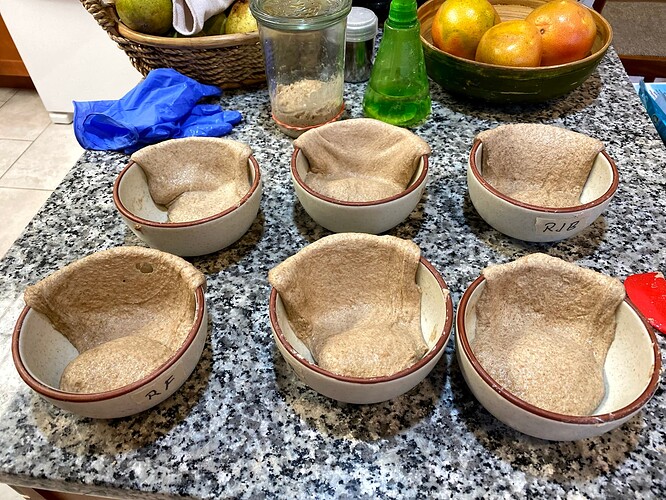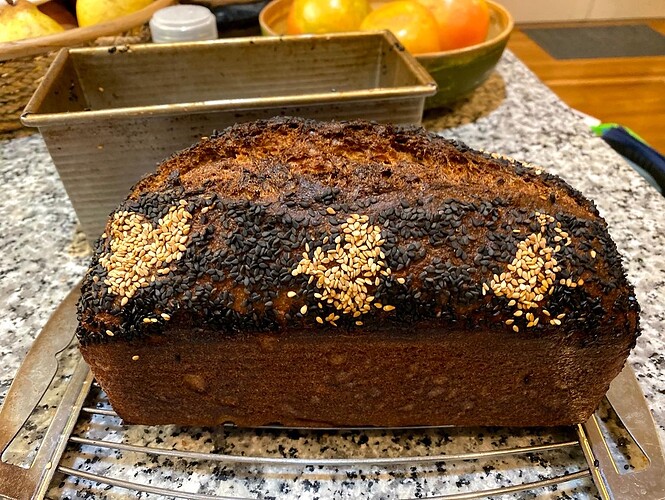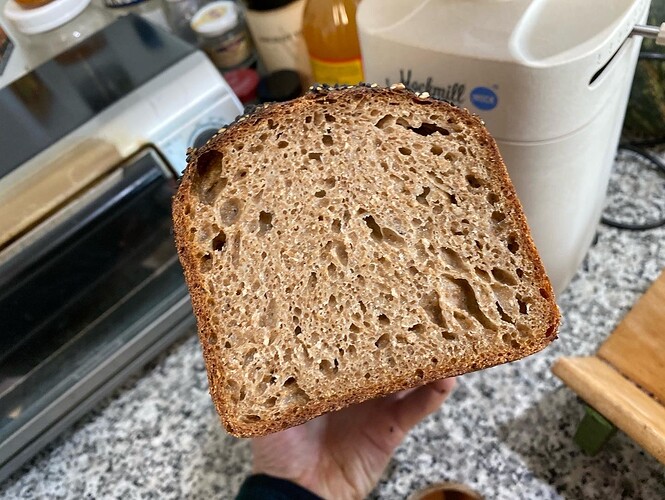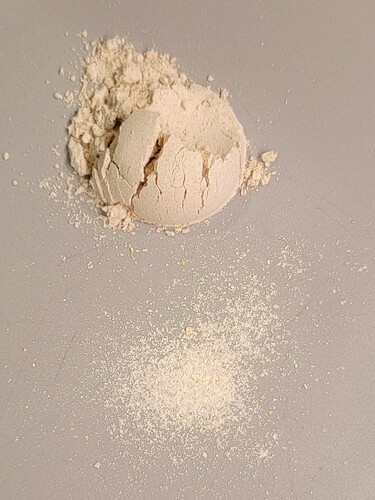Thanks, Mark. Do you put your ceramic loaf pan into a cold or preheated oven?
Fantastic information in your wonderful article. Thank you!
Would the same principles apply to baking with whole rye flour, since it also has little-to-no gluten?
Preheated. Some people swear by starting with a cold oven, but I haven’t experimented with this.
No. With wheat breads, the gluten network traps the gases produced by fermentation causing the bread to rise. While rye dough does contain some gluten, it is inadequate to trap gasses in the same manner. Instead, rye breads depend on the pentosans in the rye absorbing water, thereby making the dough viscous. It is this viscous nature of the dough which traps the fermentation gasses, allowing the bread to rise. Rye also tends to have more amylase enzymes than wheat. These need to held in check through acidity, which is why rye breads are usually made with sourdough and often have a much larger prefermented component than sourdough wheat breads. As a result of these two factors, the methods used with rye are quite distinct. Where people go wrong in baking with rye is in treating it like wheat. 
Thanks, Mark, I’ll give that a try.
While working with Melissa on this guest blog, the idea came up to use a slurry test to compare three heritage wheats sold by Breadtopia: Rouge de Bordeaux, Red Fife, and Turkey Red. I had also been meaning to test some Catawba wheat grown in NC, so this was a good opportunity to do so. As usual, I used some Horse Heaven Hollis from the Moon Family Farm as my control. And then, while getting ready to mill the other grains, I thought, let’s throw in some Yecora Rojo, also from Breadtopia, since I had never tested it. (Note that my Rouge de Bordeaux is actually from Barton Springs Mill.) The first photo here shows the results after sitting out overnight. From left to right, starting in back, we have HHH, YR, RdB, then in front, RF, TR, and C. My conclusions: the YR is actually even stronger than the HHH (which is a fantastic wheat). The RdB, not surprisingly, is almost, but not quite as strong. The RF and the TR are significantly weaker, but not excessively so; to my surprise, I found the TR to be weaker than the RF (but note that, with different years or sources, this result could change). As I expected, the C is fairly weak, which is not surprising given that it has only 8.5% protein. But I should be able to work with it using the methods I describe in the blog. Then, I couldn’t put all that dough to waste, so I mixed them all into a sourdough bread at 85% hydration. After sitting out overnight, I was expecting the dough to be super extensible. Instead, no doubt due to all that strong wheat in there, my dough was beautiful and pillowy when I went to shape it. I think I could have baked it as a freestanding batard, but didn’t. I then wanted to try something I learned from Anita (@sourdough_mania) Šumer’s great new Bread Art ebook. I like putting seeds on the top of my pan loaves, but find it frustrating that so many of the seeds fall off when I turn the baked bread out of its pan. The solution - sourdough glue (get the book to find out how to make it
 ). It worked great! The bread rose well and has a very nice crumb.
). It worked great! The bread rose well and has a very nice crumb.
Thank you for posting this here. It’s interesting to see where rouge de bordeaux is especially in relation to turkey red and red fife. I used it as the stronger wheat in the bagel recipe I just posted.
Mark, I followed your link to the instructions for making malted grain. In that link, they used wheat, but I wanted to try barley. Unfortunately, I had a very low germination rate for my barley grains. Have you tried making your own malted barley and wheat? If so, do they perform any differently in the bread?
What type of barley did you use Wendy?
I used Meg Song Hull-less Barley. I’ve germinated wheat berries quite successfully in the past, but only a small percentage of the barley germinated. I was hesitant to use malted wheat just because all the commercial malt I’ve ever heard of was barley malt and wondered if there were a good reason for that.
The only thing I can find is that while hull-less barley is ok to sprout it’s an uneven sprouter. That’s for hull-less barley in general. Can’t find much on Meg Song Hull-less Barley itself.
Wendy, I’ve made malt with both barley and rye, but I haven’t done any comparisons. However, my gut tells me that it really doesn’t matter whether you use wheat, barley, or rye. But be sure to use whole grains. I wouldn’t expect pearled barley to germinate well. I would suggest you that you try again with a different batch of grain. ![]()
Thanks, Abe, that certainly bears out my experience. I actually tried sprouting them over 2 weeks, removing the sprouted grains as they germinated, and rinsing the ones that remained. Way too fussy. I finally gave up because I was worried about them getting funky from so much time being damp. In future, I’ll either buy some commercial barley malt or try making malted wheat if that’s actually effective in bread. It was worth a shot.
Thanks, Mark. The barley I was using wasn’t pearled but a whole grain hull-less variety. I also have some black barley that I might try and hope that it doesn’t germinate in the same uneven way that Abe suggested. I did a little reading about barley and according to the article, there are 4 types of barley - those used for food, feed, malt, and forage. So now I’m wondering if a hull-less variety, which is specifically grown for human food, is even appropriate for malting. Maybe it’s time to just buy some.
If you end up buying malt then a very good place to get some would be brewing stores. They’ll have loads of different types of malts to choose from. Just make sure to find out if the malt you’re buying is diastatic or not.
Gotcha! Thanks, Abe!
How does vinegar compare with ascorbic acid as an alternative?
I haven’t found a definitive answer to this question, but I’m inclined to believe you want ascorbic and not acetic acid. My takeaway from reading is that people use way more crushed Vit C tablet than @mcw.mark recommends above. Well, Mark actually recommends Camu Camu powder, but gives Vit C as an alternative. Anyway, the minute Vit C scrapings I used (see photo below) had a big impact and more seems unnecessary and possibly that it would impact flavor.
Someone asking the same question you asked (and aso not getting a clear answer):
Someone who implies it’s one half dozen the other:
https://www.dvo.com/newsletter/weekly/2015/10-30-301/cooknart7.html
Someone indicating that acetic acid is bad for gluten strength:
dusting of vit C powder and 1 tsp diastatic barley malt powder
Hello bread bakers! I’m looking for your feedback to improve the crumb and rise on my loafs. Results are small/dense, chewy, with decent rise and moderate ear.
Friday - feed and refrigerate rye starter - thick yogurt consistency
Sat - 1pm mix 80% final (70+10% for psyllium) hydrated dough
- 700 gr h2o
- 1 heaping tbl starter,
- 20 gr pink salt, (10%)
- 750 gr sprouted WW flour
- 250 gr rye flour
- 10 gr psyllium husk (1%) - very thirsty, added 50 gr h2o
- 1/2 tsp drastic malted barely
Mix is tacky and dense. Shaped and set for bulk rise 78F, 60% RH.
7 hours bulk rise with stretch and fold twice
Refrigerated overnight
Sunday 7 am preheat Dutch oven 480F
Proof dough on counter for 1 hour. Scored deep at angle.
Bake with lid 40 min + lid removed 20 min at 450F.
Cooled for several hours and sliced.
Thanks!!!
I think you could increase the hydration of the dough and that may help the crumb open up. For a dough that is mostly whole wheat flour, I think you can go with hydration in the high 70s/low 80s.



